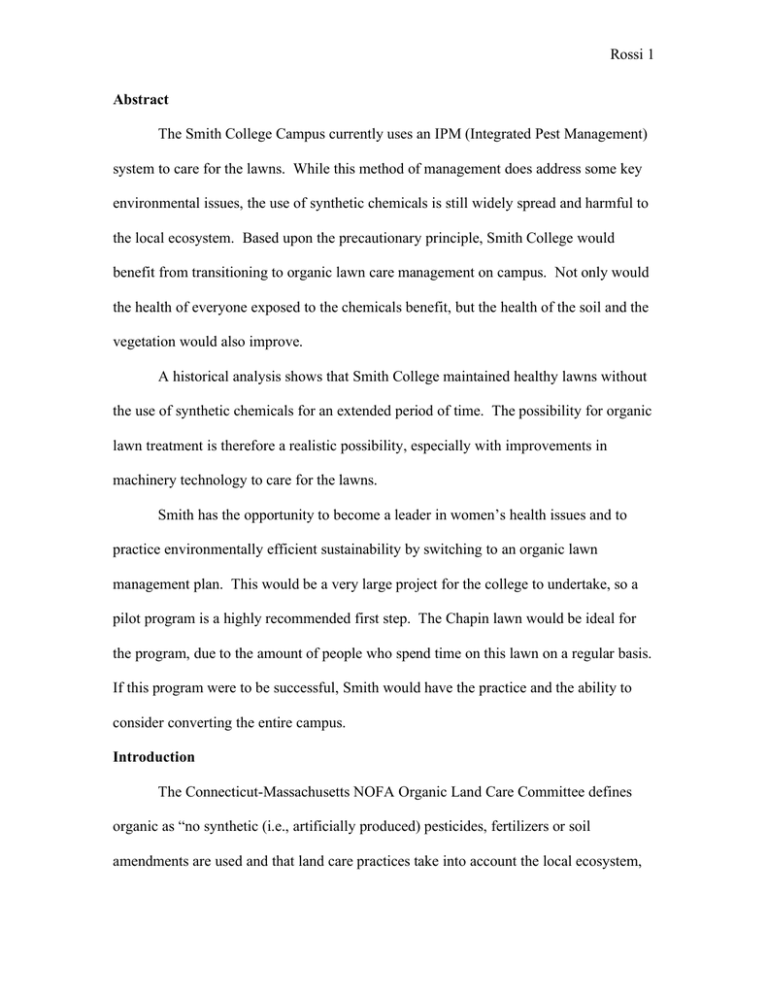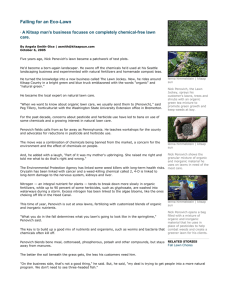Rossi 1
advertisement

Rossi 1 Abstract The Smith College Campus currently uses an IPM (Integrated Pest Management) system to care for the lawns. While this method of management does address some key environmental issues, the use of synthetic chemicals is still widely spread and harmful to the local ecosystem. Based upon the precautionary principle, Smith College would benefit from transitioning to organic lawn care management on campus. Not only would the health of everyone exposed to the chemicals benefit, but the health of the soil and the vegetation would also improve. A historical analysis shows that Smith College maintained healthy lawns without the use of synthetic chemicals for an extended period of time. The possibility for organic lawn treatment is therefore a realistic possibility, especially with improvements in machinery technology to care for the lawns. Smith has the opportunity to become a leader in women’s health issues and to practice environmentally efficient sustainability by switching to an organic lawn management plan. This would be a very large project for the college to undertake, so a pilot program is a highly recommended first step. The Chapin lawn would be ideal for the program, due to the amount of people who spend time on this lawn on a regular basis. If this program were to be successful, Smith would have the practice and the ability to consider converting the entire campus. Introduction The Connecticut-Massachusetts NOFA Organic Land Care Committee defines organic as “no synthetic (i.e., artificially produced) pesticides, fertilizers or soil amendments are used and that land care practices take into account the local ecosystem, Rossi 2 benefiting the whole web of life” (www.organiclandcare.net accessed 2006). Organic Land care is a sustainable practice for three main reasons. The first reason is that it benefits the health of the people who are potentially exposed to these chemicals. Based upon the precautionary principle, The second reason is that the local soil and vegetation becomes stronger and requires fewer resources than other systems of land management. The final reason that organic land care is more sustainable is because of the immense amount of money and energy put into the chemical branch of agribusiness. “Synthetic fertilizers are manufactured through processes that require huge amounts of energy supplied by the combustion of fossil fuels and, like synthetic pesticides, can be harmful to humans, animals, and the environment” (www.organiclandcare.net accessed 2006). The main oppositions to organic lawn care management of the Smith College campus are financial increases and the alteration of accepted aesthetics. This paper will show that while there will be initial financial increased, in the long term the college will benefit financially from a transition in lawn care. Financial increases will also be worth the additional burden to the college, because they will be addressing ecological externalities such as health and biodiversity that are generally not acknowledged by the American public. Methodology GAIA, a student-run environmental organization, invited Bernadette Giblin to come speak with its members during the fall semester of 2005. Bernadette is a Smith College alumna who runs a local business in organic lawn management. Bernadette Rossi 3 spoke of the possibilities of changing the way that Smith manages the grounds, and the potential benefits that such a conversion could produce. Bernadette discussed the necessity of using a weaning process to bring the soil and grass to away from their dependence on synthetic chemicals. The weaning process allows a slow and sustainable transition; a process which Bernadette estimates would take approximately two years. The first round of treatment would likely be an 80/20 ratio of chemical fertilizer to organic nutrients, slowly reversing the numbers. This is necessary because over time, chemical leaching is able change the overall composition of the soil. This method also prevent the entire restructuring of the grounds, a process that would be not only expensive but massively protested against, especially given the role that Frederick Olmsted (also designed Manhattan’s Central Park) had in the original landscaping of the Smith College grounds (Botanic Gardens, 2006). There are many ways to ensure that an organic lawn is a healthy lawn. An example of a simple method of lawn care management is to follow the Audubon Society’s recommendation that grass length be kept at 3-4 inches. The neatly cropped lawns are denying the grass an opportunity to grow enough to support a strong root system. The weak root system caused Smith College to launch a PDNGOTGIYGA (Please do not go on the grass if you go across) Campaign last year. It involved putting up link chains, signs, and posts to attempt to keep people from traversing the lawns. These costly precautions would not be necessary if an organic strong lawn system were in place. Bob Dombkowski, director of lawn management at Smith College’s Physical Plant, described the basic outline of the lawn care system currently in place for the Rossi 4 ground’s thirty acres and eleven athletic fields. Unfortunately, even though I spoke with Mr. Dombkowski a month ago, the MSDS (Material Safety Data Sheets) still did not come in through the mail in order for me to research and analyze the specific chemicals used on campus. The physical plant is constantly reformulating their chemical treatment process, and they find that they have to change chemicals every year, because a report will come out on hazardous health effects, they need a stronger dose chemical, or the chemicals used in previous years were experimental or ineffective. This alone should be reason enough to switch to an organic lawn system, because the chemical reformulation process is indicative of the uncertainties and risks associated with this type of lawn care, which are unnecessary considering the available alternatives. However the physical plant is understaffed and organic lawn management is a labor intensive project. A transition would be needed not only in the lawn care management, but in the way that the physical plant allocates finances. A switch to support local workers should offset costs going toward the chemicals bought from the agribusiness, and is a more sustainable way to address the community’s economy. A historical component was brought into the research to determine what Smith College had done with lawn care management before agribusiness. At one point, healthy lawns existed without the use of fertilizer. The records at the Physical Plant do not go back in time far enough to indicate if this was ever true. The records at the Smith College Archives are mainly photo, journal, and academic documents, so there were no statistics on the history of synthetic chemical use on campus. However, there were photographs of the Smith College campus lawns dating as early as 1880 in which the lawns appeared as extensive and lush (Figures 1&2). Rossi 5 Research was next conducted to indicate whether or not synthetic chemicals were even available on the market for Smith College to use. It turns out that the first superphospate fertilizer, patented by John Lawes, was not even mined outside of Europe until 1888 in Florida (McNeill 2000). Until that point, it was only mined on a very small scale due to the scarcity of the resource in Europe. Even after mining for superphosphate fertilizer began, the fertilizer was not very effective or efficient until 1914, when the Haber-Bosch process was invented (McNeill 2000). The Haber-Bosch process did not even leave Germany until post-World War II, which placed drastic limits on large-scale agriculture (Zmaczynski accessed 2006). However, by 1940, 4 million tons of artificial fertilizer was being used worldwide. In 1965, this number rose to 40 million tons, and by 1990 the number grew exponentially to 150 million tons (McNeill 2000). It is safe to assume that Smith College began using synthetic chemicals sometime after World War II, and if they used chemicals before this time than they were probably not powerful enough to alter local ecosystems. Results The current management system of Integrated Pest Management (IPM) uses six key components. The first is to allow for acceptable pest levels. The emphasis here is on control, not eradication. The Physical Plant perceives a population of three to four beetles per square foot acceptable, as opposed to the record of fifty beetles per square foot found in one location a few years ago. The second principle of IPM is preventive cultural practices. This involves selecting varieties best for local growing conditions, and maintaining healthy crops as the first line of defense. Smith College uses several different species of grass. Areas that Rossi 6 receive a lot of traffic get a Bluegrass mix, shaded areas get a fescue mix, and temporary seeding or nurse grass regions use a rye grass blend. However, Smith College could benefit from looking more into the natural ecology of Western Massachusetts. Moss grows better in shaded areas than grass, and would provide a more thorough method of polycropping (Giblin 2006). Currently, crabgrass or bare soil surrounds most trees, as even shade-grown grass does not survive well beneath trees (Figure 4). Monitoring, or regular observation, is the cornerstone of IPM. Visual inspection, insect traps, and other measurement methods are used to monitor pest levels. Record-keeping is essential, as is a thorough knowledge of the behavior and reproductive cycles of target pests. Mechanical controls are used, and should a pest reach an unacceptable level, mechanical methods are the first options to consider. They include simple handpicking, erecting insect barriers, using traps, vacuuming, and tillage to disrupt breeding. There are also natural biological processes and materials which can provide control, with minimal environmental impact, and often at low cost. The main focus here is on promoting beneficial insects that eat target pests. Chemical controls are considered as an IPM last resort, synthetic pesticides may be used when other controls fail or are deemed unlikely to prove effective. Biological insecticides are included. While this may be true for most IPM systems. Smith College sprays on a regular annual basis, in addition to any necessary spraying. Fertilizers are applied every spring, and pesticides/herbicides are applied about 2-3 times a year (Dombkowski 2006). Rossi 7 Fertilizers promote growth but can also have harmful effects on the grass, soil, and groundwater. The “three principle constituents of commercial fertilizers are nitrates, phosphates, and potash…the compounds must be soluble in order for plants to use them, but that means that they can also dissolve in surface water and groundwater bodies” (Montgomery 2006). Beyond the damage that the fertilizer has on groundwater system, it requires an incredible amount of water to activate. Organic lawn management does not require as much water, and even attempts to use grey water in most cases, or recycled water from such sources as rooftop run-off. Drainage from the Chapin Lawn runs into Paradise Pond, and subsequently carriers many nitrates into the infiltration. Currently, Smith College is removing the filter-strip of trees from alongside Paradise Pond. Vegetation acts as a filter for harmful pollutants that might otherwise reach a water course. Smith is removing these trees right now because of the damage done to them by beavers, but there is not a vegetationreplacement system in place right now. Eutrophication is another side effect of fertilizer use and the way that is damages local hydrology systems. Eutrophication is the process in which fertilizer run off, in the form of nitrates, allows the algae in nearby bodies of water to grow quickly, using up oxygen and blocking sunlight needed by other organisms. The aquatic flora begins to die off, increasing the competition for oxygen. As the lack of oxygen increases, aquatic life begins to die off and algal blooms take over (BBC 2006; Figure 5). The main effects that fertilizers have on the soils are nitrification and dentrification. Nitrification is the process of the bacterial fixing of nitrogen. Rossi 8 Dentrification is the release of nitrogen into air, in which small amounts of nitrous oxide (a hazardous gas) is also released. The Grounds Department at Smith College is aware of the problems associated with fertilizer use and has changed brands four times since 1996. In 1996, there was even an attempt to use Milogranite, a fertilizer made from sewage compounds, but the smell was overwhelming and the product was never used. (Dombkowski 2006). As mentioned earlier, the main pest on the Smith College campus is the Japanese Beetle Grub. Smith College currently uses the pesticide biphentheyn, which replaced last year’s Talstar. There was a replacement because Talstar was discovered to…But this is the nature of pesticides. “Pesticides are designed to be poisons…They are linked to a wide variety of health problems, such as cancer, asthma, birth defects, learning disabilities, and behavioral disorders” (The Alliance for a Healthy Tomorrow 2006). The physical plant uses a sprayer which has a control mechanism to regulate the amount of liquid released at any given time. However, this does not address the categorical damages that pesticides cause. The main pesticide used by the Smith College Grounds Department is Merit 75. Merit 75 “affects the thyroid, neural functions, and causes decreased fetus weight in laboratory animals” (Merit 75 WSP 1994). These are significant health risks, and are not a necessary risk for the college to make. Pesticides and herbicides have subtle erosive effects on the soil. “The loss of nutrients and organic matter through topsoil erosion may decrease the activity of soil microorganisms that normally speed the breakdown of many toxic agricultural chemicals” (Montgomery 2006). Rossi 9 Herbicides are used to terminate the two major weeds on campus: the broadleaf and crabgrass. Crabgrass (Digitaria species) is “a warm-season annual grass believed to have originated in southern Africa. The grass was used as forage in Europe before settlers unintentionally brought it to the United States.”(www.plantmanagementnetwork.org/ accessed 2006). Crabgrass can be found all over campus, as well as all over western Massachusetts. It is an invasive species that has thrived. Smith College sprays herbicide on an annual cycle and when there needs to be more control over the species. Fungicides are used primarily on the athletic fields. In seasons with more precipitation, there is a greater growth rate of fungal plants and thus a greater quantity of fungicide is used by the physical plant. The athletic fields are in very close proximity to Paradise Pond, and have the easiest ability to enter the water system. In order to convince the college that this environmental issue is important enough to be taken into consideration, the effects that synthetic chemicals have upon people must be emphasized. In particular, Smith must recognize that this issue is a women’s health prerogative. Pregnancy is a particular time of concern, for “increased fat exchange, for example in pregnancy and lactation, and cyclic hormonal changes may also result in greater sensitivity to pesticide exposure in women” (Jacobs 2003). Since World War II, “more than 85,000 synthetic chemicals have been introduced into commerce; yet fewer than 10 percent have been tested for their effects on human health.”(CalBBC 2006). We are all exposed to these chemicals on a daily basis through our food, the air we breathe, the water we drink and through daily use of thousands of consumer products. Many of these chemicals are persistent and bioaccumulative, building up in the food chain and our bodies. Modern biomonitoring methods have detected Rossi 10 hundreds of these chemicals in our breast milk, blood, urine and even in the umbilical cord blood of newborns. A growing body of scientific evidence is showing that these chemicals are affecting our health, our reproduction and our intelligence. In the last fifty years, concurrent to the rise in our exposure to these chemicals, we’ve seen increases in most types of cancer, birth defects, learning disabilities, infertility, reproductive problems and many other diseases in the industrialized world. We have also begun to see changes in wildlife exposed to these chemicals. For example, in the last several years, scientists have found increasing numbers of fish and polar bears with both male and female reproductive organs and high levels of synthetic, hormone-mimicking chemicals. Most of the chemicals that are put into products do not face federal regulations, on the grounds that most materials put into goods are protected by “trade secrets”. The few chemical bans are also difficult to enforce. Under TOSCA or TSCA, (Toxic Substances Control Act, 1976), the EPA requires companies to keep records of any health effects that their products may have on people and to carefully record chemical ingredients (EPA accessed 2006). According to GAO (Government Accountability Office), the EPA does not routinely assess the risks of all existing chemicals and the EPA faces challenges in obtaining the information necessary to do so. The EPA's reviews of new chemicals provide limited assurance that health and environmental risks are identified before the chemicals enter commerce (GAO 2005). Combined with a growing body of scientific data demonstrating the effects of toxic chemicals on human health, biomonitoring could be an essential mechanism to demonstrate the inadequacy of current Rossi 11 federal chemicals policy and the need to shift to a more precautionary principle-based policy. Transgenerational effects of chemical accumulation are starting to receive more attention in the scientific community. A recent Cord Blood Study, conducted by the Environmental Working Group (EWG) proved that many chemicals are passed on from a mother to a fetus (EWG 2005). The individual will have widely varying reactions to different chemicals, and “depending on your age, sex, and hormonal status, the same dose can have wildly different effects” (Colburn 1996). Different chemicals will also have adverse effects, depending on dosage, toxicity, bioaccumulation, and degradation rates. Dosage is a particularly complicated issue, because the incorrect assumption is that as chemicals increase in concentration, they also increase in effect. However, “in some cases a high dose may paradoxically cause less damage than a lower dose.”(Colburn 1996). For example, a particular pesticide may be most lethal when exposure is at a median amount and be safe for humans when they are exposed to greater quantities of the pesticide (Figure 6). Another unpredictable factor is the degradation rate of a chemical. For example, PCBs last a lot longer in the body than most chemicals, and are passed through the food chain easily due to their resistance to break down once inside fatty tissue. Finally, there is the complication of exposure to multiple chemicals over time, or a ‘chemical cocktail’ being concocted within the body. When chemicals combine with each other and with natural enzymes, the body has unpredictable reactions. In one study, cancerous “cells showed pronounced proliferation when the same small quantities of the Rossi 12 same ten chemicals were given together,” (Colburn 1996) versus the mild effects that these chemicals had when applied singularly. The chemical reactions taking place within the human body are unpredictable and potentially dangerous. Tables and Figures: Figure 1: Smith College in 1880, courtesy of the Smith College Archives. Figure 2: Chapin Lawn in 1880, courtesy of the Smith College Archives. Rossi 13 Figure 3: Crabgrass is shown growing on the base of a tree in Chapin Lawn. Local Ecology suggests that a moss species would grow better in this situation. Photographs by author. Figure 4: Nitrification/Dentrification and Eutrophication are the main problems associated with fertilizer’s entrance into the ecosystem. Images are from the BBC. Assumption: Possible Scenario #1: Possible Scenario #2: Rossi 14 Figure 6: Graphs interpreted from literature regarding adverse effects of chemicals on the human body. Figure 7: Chapin Lawn on a sunny day (April 12, 2006), with many students eating a grab n’ go lunch. Photograph by author. Figure 8: This return of Investment analysis was drawn up by Bernadette Giblin of Safeground Landcare for Northampton’s Cooley Dickinson Hospital. Discussion Ilana Moir wrote an ES&P sustainability project paper in 2003 extensively outlining the chemical use on the Smith College lawns and the effects that these chemicals have on the local ecosystem. In her conclusion, she said that “by looking into Rossi 15 less toxic and less persistent alternatives, the negative impacts on people, animals, and the environment can be minimized” (Moir 2003). But she did not suggest how to go about doing this. Recently, other college campuses have proven that the transition to organic lawn management is a possible and progressive move for a college to make. Alleghany College in Pennsylvania has proven that a complete transition is possible while maintaining healthy-looking and aesthetically pleasing lawns. Last year, Tufts University launched a pilot program that converted 2 acres of the campus, near playgrounds and residential buildings, to organic lawn management. When I contacted Tufts about their program, they informed me that Harvard University had been communicating with them about a pilot project which is being planned on their campus. Chapin Lawn would be an ideal lawn to begin converting to organic lawn management. Last year Grab n’ go, a lunch program at Smith began, and since then every sunny day students eat their lunch on this lawn (Figure 7). Are the students aware of what they are exposing themselves to, especially within such close proximity of the synthetic chemicals? Smith College should take a responsible step and remove this threat to the people who spend time on the campus. Although the initial leaching process would be a financial burden to the college, the overall conversion project would save the college money. The Cooley Dickinson Hospital in Northampton recently looked into such a project, and the analysis shows that organic lawn management is a cheaper way to care for lawns (Figure 8). More money would need to be spent on labor, however, making the ultimate cost analysis negative. However, Smith College would be addressing ecological externalities such as Rossi 16 health and water treatment that are often ignored by society but deserve attention. “The US Center for Disease and Control (CDC), in a study conducted of 9,282 people nationwide, found pesticides in 100% of the people who had both blood and urine tested. The average person carried 13 of the 23 pesticides used” (Alliance for a Safe Tomorrow 2006). Everyone is affected by pesticide use, and Smith College needs to address this issue. A transition to organic lawn management is an efficient and sustainable move for any college to make. A trial-run using the pilot project of the Chapin Lawn would ensure that the college avoids making any large monetary risks while simultaneously supporting an important health initiative on campus. Literature Cited The Alliance for a Healthy Tomorrow. Creating a Safer Massachusettes. www.healthytomorrow.org (May 1, 2006). BBC. “Effect of Fertilizers” <http://www.bbc.co.uk/schools/gcsebitesize/biology/livingthingsenvironment/3impactofh umansrev5.shtml> (April 12, 2006) The California Body Burden Campaign. <http://www.calbbc.org/site/pp.asp?c=9eIELMMAG&b=65900> (April 12, 2006). Colborn, Theo and Dianne Dumanoski, and John Myers. Our Stolen Future. New York City; Penguin Books, 1996, page 140. EPA. “Greenscaping’ Your Lawn and Garden” <http://www.epa.gov/epaoswer/non-hw/green/pubs/home-gs.pdf> (April 19, 2006). EPA. “Toxic Substance Control Act” <http://www.epa.gov/region5/defs/html/tsca.htm> (April 16, 2006). EWG. “Body Burden: the Pollution in Newborns”, July 21, 2005. <http://www.ewg.org/reports/bodyburden2/release_20050721.php> (April 20, 2006). Government Accountability Organization. “Chemical Regulation: Options Exist to Improve EPA's Ability to Assess Health Risks and Manage Its Chemical Review Rossi 17 Program” June 13, 2005. < http://www.gao.gov/docsearch/abstract.php?rptno=GAO-05458> (April 20, 2006). Interview with Bob Dombkowski of the Physical Plant at Smith College, April 11, 2006. Interview with Bernadette Giblin of Safeground Lawncare, April 6, 2006. Jacobs, Miriam and Barbara Dinham. “Silent Invaders: Pesticides, Livelihoods, and Women’s Health”. London: Zed Books; 2003. McNeil, J.R. An Environmental History of the Twentieth Century: Something New Under the Sun. New York; W.W. Norton Company, 2000. Merit 75 WSP. 1994. Material Safety Data Sheet. Bayer Corporation. Kansas City, MO. Moir, Ilana. “The ‘Greening of Smith College Campus” Unpublished Report. May 6, 2003. Montgomery, Carla. Environmental Geology, 7th edition. Boston: McGraw Hill, 2006. Organic Land Care Committee of Connecticut and Massachusetts. “Frequently Asked Questions about Organic Land Care” <http://www.organiclandcare.net/faq.php#moreexpensive> (April l29, 2006). Plant Management Network International. “Fast, Easy, Applied Solutions in Agriculture”. <http://www.plantmanagementnetwork.org/> (April 20, 2006). Smith College. “The Botanic Gardens of Smith College” March 28, 2006. <http://www.smith.edu/garden/home.html> (April l29, 2006). “Tufts: Sustainable Landscape Initiative” http://www.tufts.edu/tie/sustainableLandscaping/Organic%20turf%20management.htm Zmaczynski, Raymond. “The Effect of the Haber Process on Fertilizers”. <http://www.princeton.edu/~hos/mike/texts/readmach/zmaczynski.htm> (April 16, 2006).




